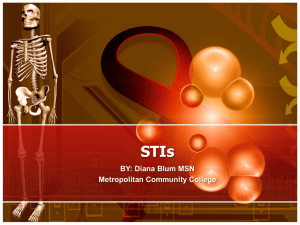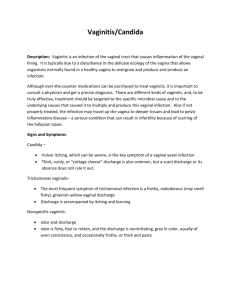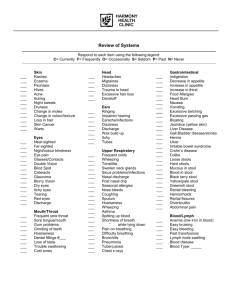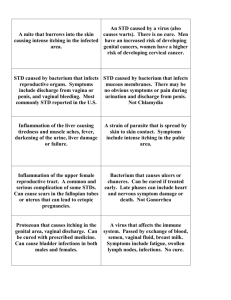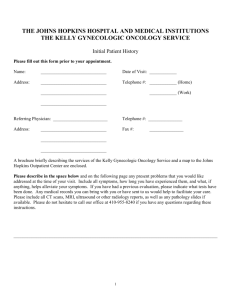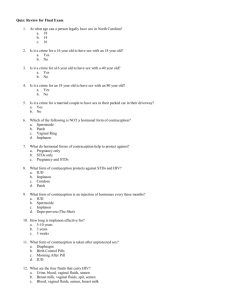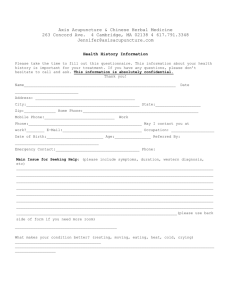Information on Sexually Transmitted Diseases
advertisement
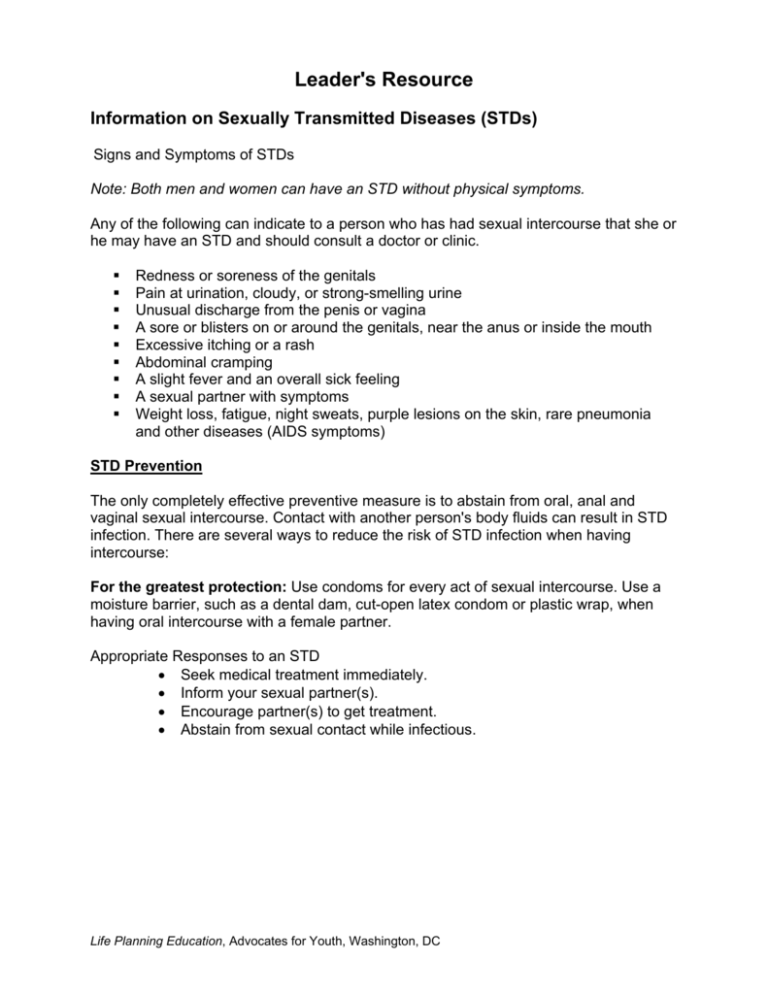
Leader's Resource Information on Sexually Transmitted Diseases (STDs) Signs and Symptoms of STDs Note: Both men and women can have an STD without physical symptoms. Any of the following can indicate to a person who has had sexual intercourse that she or he may have an STD and should consult a doctor or clinic. Redness or soreness of the genitals Pain at urination, cloudy, or strong-smelling urine Unusual discharge from the penis or vagina A sore or blisters on or around the genitals, near the anus or inside the mouth Excessive itching or a rash Abdominal cramping A slight fever and an overall sick feeling A sexual partner with symptoms Weight loss, fatigue, night sweats, purple lesions on the skin, rare pneumonia and other diseases (AIDS symptoms) STD Prevention The only completely effective preventive measure is to abstain from oral, anal and vaginal sexual intercourse. Contact with another person's body fluids can result in STD infection. There are several ways to reduce the risk of STD infection when having intercourse: For the greatest protection: Use condoms for every act of sexual intercourse. Use a moisture barrier, such as a dental dam, cut-open latex condom or plastic wrap, when having oral intercourse with a female partner. Appropriate Responses to an STD • Seek medical treatment immediately. • Inform your sexual partner(s). • Encourage partner(s) to get treatment. • Abstain from sexual contact while infectious. Life Planning Education, Advocates for Youth, Washington, DC Common Sexually Transmitted Diseases Chlamydia Symptoms: Although it is the most prevalent STD in the United States today, chlamydia is difficult to diagnose because the disease often coexists with others. In addition to gender-specific symptoms described below, the eyes may become infected, producing redness, itching and irritation. Infection of eyes can result from an infected person touching her or his genitals and then her or his eyes. Males: Twenty-five percent of men have no symptoms; when they have symptoms, men may experience a painful or burning sensation when they urinate and/or a watery or milky discharge from the urethra. Females: Seventy-five percent of women have no symptoms; for women with symptoms, these may include abnominal vaginal discharge, irregular vaginal bleeding, abdominal or pelvic pain accompanied by nausea and fever. May also cause painful urination, blood in the urine, or a frequent urge to urinate. Diagnosis: A sample of genital excretions is cultured to detect chlamydia Damage: If left untreated, chlamydia may cause severe complications, such as non-gonococcal urethritis (NGU) in men and pelvic inflammatory disease (PID) in women. Treatment: Chlamydia is caused by bacteria that are effectively eliminated by tetracycline or erythromycin; penicillin will not eliminate chlamydia. Gonorrhea Symptoms: May occur 2 to 10 days after contact with infected person. Males: A cloudy (thick, grayish-yellow) pus-like discharge from the penis and a burning sensation during urination. Symptoms appear 2 to 10 days after contact. Twenty percent or more of males show no signs. Females: Usually show no signs. Some women have a pus-like vaginal discharge, vaginal soreness, irregular bleeding, painful urination and lower abdominal pain 2 to 10 days after contact. Damage: Sterility; pelvic inflammatory disease (PID) in women which can recur even after the gonorrhea and original PID have been cured. Diagnosis: The patient should inform the physician of all points of sexual contact (genitals, mouth or anus). Males: Medical practitioner examines genitals, mouth and/or anus for signs of irritation, soreness or discharge and takes a bacterial culture from any infected area Life Planning Education, Advocates for Youth, Washington, DC Females: Medical practitioner examines genitals, mouth, lymph glands and cervical discharges and takes a bacterial culture from any infected area. Treatment: Penicillin or similar antibiotic that kills the bacteria within one to two weeks. Genital Herpes Symptoms: Caused by the herpes simplex virus and transmitted through direct skin-to-skin contact during vaginal, anal or oral sex. Although some people have no symptoms, most experience an itching or burning sensation, often developing into painful blister-like lesions on or around genitals or in anus; first symptoms appear 2-10 days after exposure and last 2-3 weeks. Some people have no symptoms. Damage: Recurring outbreaks of the painful blister occur in one third of those who contract herpes. Herpes may increase the risk of cervical cancer and can be transmitted to a baby during childbirth. Diagnosis: Microscopic examination of blister tissue. Treatment: Genital herpes is caused by a virus and has no cure at present. Available drug treatments are aimed at relieving the pain of active sores and reducing the frequency and duration of outbreaks. Syphilis Symptoms: Painless chance sore on or in genitals, anus, mouth or throat. Appears 10 days to three months after contracted. If left untreated, a skin rash will develop, often on the hands and soles of feet, 3 weeks after the chancre appears. Other symptoms may include hair loss, sore throat, fatigue or mild fever. Damage: If left untreated after the rash appears, it can eventually cause heart failure, blindness and damage to the brain and spinal cord. Diagnosis: Medical practitioner examines chance site, eyes, throat, heart lungs and abdomen; performs a microscopic examinatbon of chance pus and a blood test. Treatment: Penicillin or similar antibiotic that kills the bacteria Genital Warts (HPV) Symptoms: Genital warts are the result of a virus spread during sexual contact. They often grow together in little clusters on and inside the genitals, anus and throat. Depending on location, they can be pink or red and soft, or small, hard and yellowish-gray. Damage: Some HPV-caused lesions on the cervix are associated with an increased risk of cervical cancer. Life Planning Education, Advocates for Youth, Washington, DC Diagnosis: Usually made by direct eye exam. A Pap smear may also indicate the presence of HPV. Treatment: Locally applied treatments or surgery can be used to remove the warts, but cannot kill the virus. It is important to remove the warts to keep the virus from spreading. Genital warts often return after removal. Pelvic Inflammatory Disease (PID) An infection that affects the fallopian tubes, uterine lining and/or ovaries. It is usually caused by sexually transmitted diseases that enter the reproductive system through the cervix. Symptoms: While the symptoms vary from person to person, the most common identifying factor is pain in the pelvic regions. Other symptoms may include frequent urination and/or burning with urination, sudden fevers, nausea or vomiting, abnormal vaginal discharge, and/or pain or bleeding after intercourse. Damage: If left untreated, PID can cause infertility or ectopic pregnancy. Diagnosis: In order to make a diagnosis, it is necessary to determine the original source of the infection. Treatment: Both partners must be treated with antibiotics Yeast Infection (Monilia, Candida or fungus) Symptoms: A yeast infection caused by an imbalance of the vaginal organisms. Females: Itching burning, dryness of the vagina, whitish and lumpy (cottage cheese like) discharge that smells like yeast. Males: Inflammation of the penis. Diagnosis: Microscopic analysis of vaginal secretions. Treatment: Locally applied cream or vaginal suppositories. Trichomoniasis Symptoms: A vaginal infection that is most often contracted through intercourse, but can also be transmitted through moist objects such as wet clothing, towels, washcloths and so on. Females: A burning sensation at urination and an odorous, foamy discharge, along with a reddening and swelling of the vaginal opening. Males: Usually have no symptoms but might have a slight discharge, itching and/or lesions. Life Planning Education, Advocates for Youth, Washington, DC Damage: Can cause urinary infections. Diagnosis: Usually diagnosed by microscopic analysis of vaginal discharge. Treatment: Oral medication. HIV Infection and AIDS For further information about HIV/AIDS, see the Leader's Resource, “HIV Infection and AIDS Informatiion.” Symptoms: One to two months after infection, some people experience a brief illness similar to a cold or the flu. An average of 7-10 years later, symptoms such as weight loss, yeast infections, night sweats, swollen lymph glands, persistent cough, diarrhea, fatigue and loss of appetite may begin to occur. Damage: People with HIV infection eventually develop AIDS and become ill with one or more serious diseases called opportunistic infections. The long-term outcome is gradual debilitation and, ultimately, death. Treatment: At this time there is no cure. People are now living with AIDS much longer than they did in the 1980s, due to the development of drugs that treat some of the opportunistic infections. Medical treatment may also alleviate short-term symptoms. Life Planning Education, Advocates for Youth, Washington, DC

